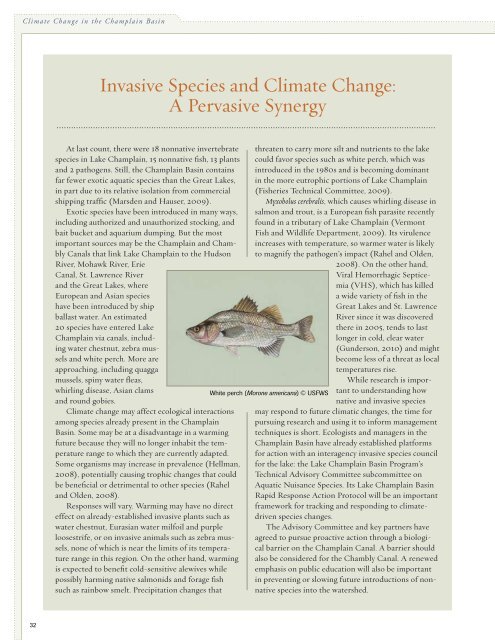Climate Change in the Champlain Basin - The Nature Conservancy
Climate Change in the Champlain Basin - The Nature Conservancy
Climate Change in the Champlain Basin - The Nature Conservancy
You also want an ePaper? Increase the reach of your titles
YUMPU automatically turns print PDFs into web optimized ePapers that Google loves.
<strong>Climate</strong> <strong>Change</strong> <strong>in</strong> <strong>the</strong> Champla<strong>in</strong> Bas<strong>in</strong>Invasive Species and <strong>Climate</strong> <strong>Change</strong>:A Pervasive SynergyAt last count, <strong>the</strong>re were 18 nonnative <strong>in</strong>vertebratespecies <strong>in</strong> Lake Champla<strong>in</strong>, 15 nonnative fish, 13 plantsand 2 pathogens. Still, <strong>the</strong> Champla<strong>in</strong> Bas<strong>in</strong> conta<strong>in</strong>sfar fewer exotic aquatic species than <strong>the</strong> Great Lakes,<strong>in</strong> part due to its relative isolation from commercialshipp<strong>in</strong>g traffic (Marsden and Hauser, 2009).Exotic species have been <strong>in</strong>troduced <strong>in</strong> many ways,<strong>in</strong>clud<strong>in</strong>g authorized and unauthorized stock<strong>in</strong>g, andbait bucket and aquarium dump<strong>in</strong>g. But <strong>the</strong> mostimportant sources may be <strong>the</strong> Champla<strong>in</strong> and ChamblyCanals that l<strong>in</strong>k Lake Champla<strong>in</strong> to <strong>the</strong> HudsonRiver, Mohawk River, ErieCanal, St. Lawrence Riverand <strong>the</strong> Great Lakes, whereEuropean and Asian specieshave been <strong>in</strong>troduced by shipballast water. An estimated20 species have entered LakeChampla<strong>in</strong> via canals, <strong>in</strong>clud<strong>in</strong>gwater chestnut, zebra musselsand white perch. More areapproach<strong>in</strong>g, <strong>in</strong>clud<strong>in</strong>g quaggamussels, sp<strong>in</strong>y water fleas,whirl<strong>in</strong>g disease, Asian clamsand round gobies.<strong>Climate</strong> change may affect ecological <strong>in</strong>teractionsamong species already present <strong>in</strong> <strong>the</strong> Champla<strong>in</strong>Bas<strong>in</strong>. Some may be at a disadvantage <strong>in</strong> a warm<strong>in</strong>gfuture because <strong>the</strong>y will no longer <strong>in</strong>habit <strong>the</strong> temperaturerange to which <strong>the</strong>y are currently adapted.Some organisms may <strong>in</strong>crease <strong>in</strong> prevalence (Hellman,2008), potentially caus<strong>in</strong>g trophic changes that couldbe beneficial or detrimental to o<strong>the</strong>r species (Raheland Olden, 2008).Responses will vary. Warm<strong>in</strong>g may have no directeffect on already-established <strong>in</strong>vasive plants such aswater chestnut, Eurasian water milfoil and purpleloosestrife, or on <strong>in</strong>vasive animals such as zebra mussels,none of which is near <strong>the</strong> limits of its temperaturerange <strong>in</strong> this region. On <strong>the</strong> o<strong>the</strong>r hand, warm<strong>in</strong>gis expected to benefit cold-sensitive alewives whilepossibly harm<strong>in</strong>g native salmonids and forage fishsuch as ra<strong>in</strong>bow smelt. Precipitation changes thatthreaten to carry more silt and nutrients to <strong>the</strong> lakecould favor species such as white perch, which was<strong>in</strong>troduced <strong>in</strong> <strong>the</strong> 1980s and is becom<strong>in</strong>g dom<strong>in</strong>ant<strong>in</strong> <strong>the</strong> more eutrophic portions of Lake Champla<strong>in</strong>(Fisheries Technical Committee, 2009).Myxobolus cerebralis, which causes whirl<strong>in</strong>g disease <strong>in</strong>salmon and trout, is a European fish parasite recentlyfound <strong>in</strong> a tributary of Lake Champla<strong>in</strong> (VermontFish and Wildlife Department, 2009). Its virulence<strong>in</strong>creases with temperature, so warmer water is likelyto magnify <strong>the</strong> pathogen’s impact (Rahel and Olden,2008). On <strong>the</strong> o<strong>the</strong>r hand,Viral Hemorrhagic Septicemia(VHS), which has killeda wide variety of fish <strong>in</strong> <strong>the</strong>Great Lakes and St. LawrenceRiver s<strong>in</strong>ce it was discovered<strong>the</strong>re <strong>in</strong> 2005, tends to lastlonger <strong>in</strong> cold, clear water(Gunderson, 2010) and mightbecome less of a threat as localtemperatures rise.While research is importantto understand<strong>in</strong>g hownative and <strong>in</strong>vasive speciesmay respond to future climatic changes, <strong>the</strong> time forpursu<strong>in</strong>g research and us<strong>in</strong>g it to <strong>in</strong>form managementtechniques is short. Ecologists and managers <strong>in</strong> <strong>the</strong>Champla<strong>in</strong> Bas<strong>in</strong> have already established platformsfor action with an <strong>in</strong>teragency <strong>in</strong>vasive species councilfor <strong>the</strong> lake: <strong>the</strong> Lake Champla<strong>in</strong> Bas<strong>in</strong> Program’sTechnical Advisory Committee subcommittee onAquatic Nuisance Species. Its Lake Champla<strong>in</strong> Bas<strong>in</strong>Rapid Response Action Protocol will be an importantframework for track<strong>in</strong>g and respond<strong>in</strong>g to climatedrivenspecies changes.<strong>The</strong> Advisory Committee and key partners haveagreed to pursue proactive action through a biologicalbarrier on <strong>the</strong> Champla<strong>in</strong> Canal. A barrier shouldalso be considered for <strong>the</strong> Chambly Canal. A renewedemphasis on public education will also be important<strong>in</strong> prevent<strong>in</strong>g or slow<strong>in</strong>g future <strong>in</strong>troductions of nonnativespecies <strong>in</strong>to <strong>the</strong> watershed.White perch (Morone americana) © USFWS32
















